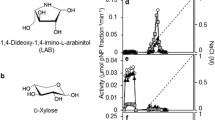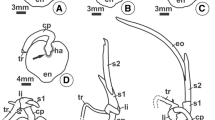Summary
The reserve endosperm galactomannans of fenugreek (Trigonella foenum-graecum L.), crimson clover (Trifolium incarnatum L.) and lucerne (Medicago sativa L.) are broken down to free galactose and mannose in dry-isolated endosperms (devoid of embryo) incubated under germination conditions. Breakdown is prevented by inhibition of protein synthesis or of oxidative phosphorylation in the aleurone layer. Resting aleurone cells contain inter alia a large number of ribosomes more or less regularly distributed in the ground plasma. At the onset of germination, before galactomannan breakdown begins, polysomes are formed and seem, at least partly, to become associated with vesicles and flat cisternae both probably newly formed and derived from ER. Concurrently with galactomannan breakdown in the reserve cells, wall corrosion occurs in the aleurone layer, the contents of the aleurone grains disappear and the rough vesicles and cisternae proliferate. Later a large central vacuole is formed which incorporates smaller vacuoles emerging from the cytoplasm, and at the same time the rough ER vesicles and cisternae become highly distended.
It is concluded that the cells of the aleurone layer are responsible for the synthesis and secretion into the storage cells of the enzymes necessary for galactomannan degradation. The physiology of galactomannan breakdown is compared and contrasted with that of starch mobilisation in the endosperm of germinating cereal grains.
Similar content being viewed by others
References
Cohen, D., Paleg, L. G.: Physiological effects of gibberellic acid. X. The release of gibberellin-like substances by barley embryo. Plant Physiol. 42, 1288–1296 (1967).
Fischer, F. G., Dörfel, H.: Die quantitative Bestimmung reduzierender Zucker auf Papierchromatogrammen. Hoppe-Seylers Z. physiol. Chem. 279, 164–178 (1954).
Forsyth, W. G. C.: Colour reagents for the paper chromatography of sugars. Nature (Lond.) 161, 239–240 (1948).
Hough, L., Jones, J. K. N., Wadman, W. H.: Quantitative analysis of mixtures of sugars by the method of partition chromatography. Part V. Improved methods for the separation and detection of the sugars and their methylated derivation on the paper chromatogram. J. chem. Soc., 1702–1706 (1950).
Jones, R. L.: Gibberellic acid and the fine structure of barley aleurone cells. I. Changes during the lag-phase of α-amylase synthesis. Planta (Berl.) 87, 119–133 (1969a).
Jones, R. L.: Gibberellic acid and the fine structure of barley aleurone cells. II. Changes during the synthesis and secretion of α-amylase. Planta (Berl.) 88, 73–86 (1969b).
Jones, R. L.: Gibberellic acid and the fine structure of barley aleurone cells. III. Vacuolation of the aleurone cell during the phase of ribonuclease release. Planta (Berl.) 94, 191–202 (1970).
Matile, Ph., Winkenbach, F.: Function of lysosomes and lysosomal enzymes in the senescing corolla of the morning glory (Ipomoea purpurea). J. exp. Bot. 23, 759–771 (1971).
Paleg, L., Hyde, B.: Physiological effects of gibberellic acid. VII. Electron microscopy of barley aleurone cells. Plant Physiol. 39, 673–680 (1964).
Rambourg, M. A.: Détection des glycoproteines en microscopie électronique: coloration de la surface cellulaire et de l'appareil de Golgi par un mélange acide chromique-phosphotungstique. C. R. Acad. Sci. (Paris) (D) 265, 1426–1428 (1967).
Reid, J. S. G.: Reserve carbohydrate metabolism in germinating seeds of Trigonella foenum-graecum L. (Lequminosae). Planta (Berl.) 100, 131–142 (1971).
Reid, J. S. G., Meier, H.: Chemotaxonomic aspects of the reserve galactomannans in Leguminous seeds. Z. Pflanzenphysiol. 62, 89–92 (1970a).
Reid, J. S. G., Meier, H.: Formation of reserve galactomannan in the seeds of Trigonella foenum-graecum. Phytochem. 9, 513–520 (1970b).
Saeman, J. F., Buhl, J. L., Harris, E. E.: Quantitative saccharification of wood and cellulose. Ind. Eng. Chem., Anal. Ed. 17, 35–37 (1945).
Sweeley, C. C., Bentley, R., Makita, M., Wells, W. W.: Gas-liquid chromatography of trimethylsilyl derivatives of sugars and related substances. J. Amer. chem. Soc. 85, 2497–2507 (1963).
Trevelyan, W. E., Procter, D. P., Harrison, J. S.: Detection of sugars on paper chromatograms. Nature (Lond.) 166, 444–445 (1950).
Varner, J. E., Chandra, G. R.: Hormonal control of enzyme synthesis in barley endosperm. Proc. nat. Acad. Sci. (Wash.) 52, 100–106 (1964).
Yomo, H.: Studies on the barley malt. The sterilisation of barley seeds and the amylase formation of separated embryos and endosperms. J. Ferment. Ass. Japan. 16, 444–448 (1958).
Author information
Authors and Affiliations
Additional information
This is part three in a series of papers dealing with galactomannan metabolism. Part two: Planta (Berl.) 100, 131–142 (1971).
Rights and permissions
About this article
Cite this article
Reid, J.S.G., Meier, H. The function of the aleurone layer during galactomannan mobilisation in germinating seeds of fenugreek (Trigonella foenum-graecum L.), crimson clover (Trifolium incarnatum L.) and lucerne (Medicago sativa L.): A correlative biochemical and ultrastructural study. Planta 106, 44–60 (1972). https://doi.org/10.1007/BF00385472
Received:
Issue Date:
DOI: https://doi.org/10.1007/BF00385472




